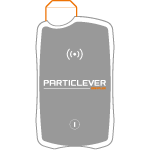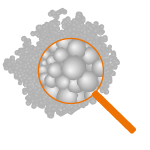Size of collected particles
From a process perspective, just after their production (using dry or wet methods), primary particles will link together more strongly the higher their concentration. In liquid suspensions, anti-coagulating agents can limit the phenomenon, but in dry processes the accumulation of materials generates aggregates and agglomerates that can reach several micrometers (or 100 to 1000 times bigger than the primary particles).
It is therefore important to note that a 100% nanoparticle powder may, in reality, contain a very small proportion of isolated particles of a size less than 100 nm.
When the process directly releases nanoparticles into the air, the phenomenon is identical: the particles will bind together in proportion to their concentration. Usually the concentrations are such that the size does not exceed 500 nm, but in certain extreme uses (like dense smoke in welding), the aggregation and agglomeration can reach several micrometers.
This is why it's necessary to sample based on the respirable fraction, which corresponds to particle sizes that can penetrate to the lung alveoli (mainly smaller than 4 micrometers or at most about 10 micrometers).
PARTICLEVER cassettes were specially developed to allow such samples to be taken.



